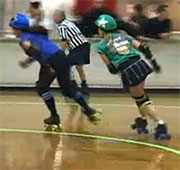
TUESDAY, March 12 (HealthDay News) — As roller-derby skaters bump and smack one another on the track, a new study finds that they’re exchanging more than bruises: These combative women are also swapping countless bacteria that live on their skin.
Researchers who analyzed skin samples were able to distinguish among teams by the bacteria on the skaters’ skin, and they could track how the bacteria moved between teams during a bout.
“The thing that was surprising was how different the teams’ different bacteria were before they played, and how similar they became afterward,” said study author James Meadow, a postdoctoral research associate at the University of Oregon in Eugene.
Germs pass from person to person, from people to things and from people to animals all day long, he said, but it’s usually harmless. “We pick them up from the environment, and we give them off to the environment,” he said. “This study was a way to find out how that changes when we come into contact with other people.”
For the study, published in the March 12 issue of the new journal PeerJ, researchers studied three roller-derby teams competing in a tournament: the Emerald City Roller Girls from Eugene, Ore.; the DC Roller Girls from Washington, D.C.; and the Silicon Valley Roller Girls from San Jose, Calif.
To obtain microbe samples, the researchers swabbed the skaters’ upper arms, which are typically exposed before, during and after a game.
Each team’s members had very similar bacteria, possibly because their players came from the same geographical places. “If we picked one of the players at random, I could tell you which team she played for,” Meadow said.
But the bacterial makeup of the skin on their arms changed after skin-to-skin contact with other skaters. “It was difficult to tell the teams apart. They had mixed a lot of their skin bacteria,” Meadow said.
Athletes can and do transmit potentially dangerous skin infections to one another, but it’s not clear if the germs transmitted between these players could have made them sick, the researcher said. When it comes to the sharing of germs, Meadow said, “we don’t know what impact that has or how long it lasts.”
Nor is it clear exactly how many bacteria transferred among skaters as they collided and fought for track position in this heavy-duty contact sport.
Still, skin infections are nothing to dismiss. A “superbug” called methicillin-resistant Staphylococcus aureus (MRSA) can be transmitted between athletes on a football field and even through shared towels. MRSA is sometimes fatal.
What about other kinds of human contact, such as handshakes, kissing and sex? The risk of body-to-body bacteria transmission from those activities is another mystery, although it’s known that the skin, mouth and vagina are home to unique communities of germs, Meadow said.
“The transmission could be at this level or more,” he said, referring to the study findings. “One thing we can say for certain is that we’re transferring things in all types of human contact” — derby or no derby.
Dr. Pascal James Imperato, dean of the School of Public Health at SUNY Downstate Medical Center in New York City, said the study demonstrates how people from the same areas have similar kinds of bacteria on their skin.
Should people worry about touching each other?
Not generally, Imperato said. “There’s no reason anyone should institute any kind of preventive measures because the majority of these bacteria are not pathogenic,” he said. “They’re garden-variety bacteria found on the skin of ordinary people. I don’t think it’s anything to worry about.”
More information
For more about skin infections, try the U.S. National Library of Medicine.

